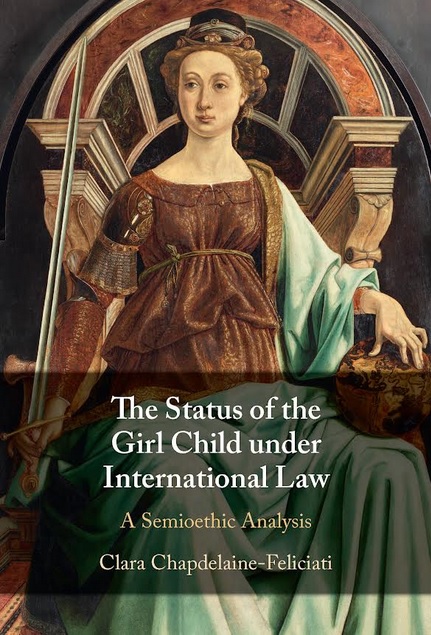We interview Clara Chapdelaine-Feliciati about her book, The Status of the Girl Child under International Law
Our member, Dr. Clara Chapdelaine-Feliciati (Xi'an Jiaotong - Liverpool University, China - the United Kingdom), talks about her new book, The Status of the Girl Child under International Law (Cambridge University Press, 2025).

Q: What is this book about?
This monograph offers the first comprehensive study of the status of the girl child under international law. I provide a history of the recognition of the girl child under international law and explore the definition of the girl child in both the English language and the international framework. Moreover, I examine the boundaries and divisions of girlhood and womanhood internationally, and discuss the public/private divide, universalism and cultural relativism, and their significance for the girl child.
This book engages in the novel legal semiotics theory to decode the meaning of international treaties, mainly the Convention on the Rights of the Child, the Convention on the Elimination of All Forms of Discrimination Against Women, and International Covenants, to assess whether treaty provisions, as formulated, clearly identify the girl child and take into account the obstacles she faces as a result of sexism, childism, and intersectional discrimination. In order to address shortcomings, I propose amendments to the content of international treaties to empower the girl child.
Additionally, the book comprises a Meaning Glossary of human rights violations specific to or predominantly experienced by girl children, in both the Global South and the Global North, from child marriage to sexualized social and dress codes on social media platforms, such as Instagram and TikTok.
This book bridges two fields usually studied separately: law and semiotics. It demonstrates the pertinence of legal semiotics as a method to interpret international treaties, and clarifies legal definitions for non-lawyers, including sociologists and educators.
Q: What made you write this book?
This book was inspired by my professional experience working with street youth in Montreal (Canada), as Child Rights Specialist at the UNICEF Office of Research in Florence (Italy), and while directing the Pan-Canadian Child Trafficking Study at the International Bureau for Children’s Rights and serving at the International Criminal Court, Prosecutor’s Office, Prosecution division (The Hague), Court of Quebec Youth division, and Tribunal pour enfants de Bobigny in Paris (France). During this time, I observed that international and domestic institutions tend to examine children and women as homogenous groups, even though the situation of girls is different from that of boys and adults, notably adult women.
The present inquiry also stems from my own girlhood in a family that incorporates both the Global South and the Global North, Brazil and Québec.
In this monograph, I apply legal semiotics as a useful method to deconstruct the textual meaning of treaties, but also the meaning-intention behind the selection of terms, and their overall significance for girl children globally. I previously adopted this method in the monograph Feminicides of Girl Children within the Family Context: An International Human Rights Law Approach (Brill 2018), to investigate whether the Feminicides of girls are addressed under the International Covenant on Civil and Political Rights (ICCPR).
This research also led me to co-found, with colleagues in several disciplines, the Girls’ Studies Research Network (2019), and conduct research on Girl Performers with the Canadian Social Sciences and Humanities Research Council IDG and Explore grants.
An excerpt from the introductory chapter (pages 38-39):
The significance of terminology in international law is that it moulds the substance of rights, their scope, as well as the extent of States parties’ obligations. In this regard, terminology shapes the notion of rights and their potential universal recognition and implementation at the domestic level, and conversely, their possible denial, dismissal or violation. The significance of terminology shall be explored in this monograph by analyzing the consequences of the formulation of rights in treaties on their substance as well as on the corresponding obligations of States parties.
We shall endeavour to answer the following questions: is the girl child clearly identified under international law? Who is protected under the umbrella of the ‘girl child’ identity vector? Is the boundary for the beginning, and for the end of girlhood, clearly delineated in the international legal framework? What happens to young women located at the frontiers of girlhood and womanhood? Are the rights of girl children phrased in sufficiently clear terms? Could they be (mis)interpreted by the dynamical and final interpretants? Do provisions, as formulated, take into consideration the obstacles that girl children face in exercising their rights? Do treaties tackle specific human rights abuses experienced by girl children, such as child marriage? Do treaties tend to focus only on certain forms of abuse, thereby disregarding other issues, such as the over-sexualization of girls and unrealistic beauty ideals? Are the rights phrased in a paternalistic approach or do they truly empower girl children? Do treaty provisions protect girl children in both the Global South and Global North, the West and East and across social classes? Finally, do treaty provisions address the intersectional discrimination experienced by girls on account of class, race, religion, culture, (dis)abilities and sexual orientation as well as girls in specific circumstances, such as armed conflict, detention and girl child refugees?